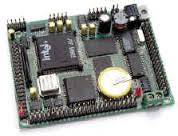
Learning about the patterns and habits of the environment often provides critical insight into some of these questions still unanswered by geologists. Many times, collected and measured data can even help geologists predict natural phenomena such as earthquakes or tornados. Historically, this very necessary data collection has had a tedious element to it, however, now data collection is being revolutionized to run entirely by remote controlled units that can measure and record any number of parameters over extended periods of time.
On the forefront of this mission of learning about geological events are our A-Engine86-P (AE86P) microcontrollers.
These controllers have been implemented in automated geological data collection systems by one of the leaders in high technology solutions for surveillance and remote sensors. It has been noted that these systems have some of the most advanced technology in the marketplace. These automated systems are self-contained units, secured into the ground and used to monitor a number of environmental factors. Using two of the possible three serial ports on-board TERN’s AE86P allows these units to be remotely controlled and monitored by either a hardwired serial interface or a wireless RF link. In this way, users interested in monitoring environmental parameters are allowed a great deal of flexibility in how the units collect data.
 One specific application is an audio analysis unit called Noisewatch. This stand-alone unit monitors ambient noise levels using the AE86P A/D converter. Any noise levels detected above a certain preset threshold can trigger the AE86P to send an alarm notice to the monitoring station. These units can also store data over time that can later be retrieved via the serial link to show noise trends as a function of time. In addition, Noisewatch units can capture impulse noise events such as: sonic booms, explosions, gunfire, or pile drivers.
One specific application is an audio analysis unit called Noisewatch. This stand-alone unit monitors ambient noise levels using the AE86P A/D converter. Any noise levels detected above a certain preset threshold can trigger the AE86P to send an alarm notice to the monitoring station. These units can also store data over time that can later be retrieved via the serial link to show noise trends as a function of time. In addition, Noisewatch units can capture impulse noise events such as: sonic booms, explosions, gunfire, or pile drivers.
Another application of the AE86P, is a similar stand alone unit, called Hydrowatch, which monitors streams and rivers. This unit also is secured into the ground and controlled by either the hardwired serial link or RF link. In this case, the unit measures water depth and flow rate in a variety of different environments including: bridges, streams, pipes, wells, reservoirs, wetlands, or roadway runoff areas. As with the previously described unit, Tern’s AE86P controller allows HydroWatch to be programmed to send alarm conditions to the monitoring station if water depth or flow rate is beyond safe levels. The HydroWatch data is then sent to the user via the Internet.
As described, both units are completely self-contained. Our AE86P controller only requires 190mA at +12VDC, and along with the wireless RF serial link, these units allow tremendous versatility on where they can be installed. All that is needed is a building, telephone pole, or tower at a sensor site. The operating and installation costs of these systems are very low since they are run by solar power charged batteries and use wireless RF communications instead of a telephone line to transmit data to the base station. As made possible by TERN’s controllers, all these aspects come together to form very innovative and effective monitoring systems.
The A-Engine86-P itself is a high performance C/C++ programmable controller based on 40 MHz, 16-bit CPU and measures only 3.6” x 3.2”. Offering a 16-bit external data bus, the AE86P supports 256 KW 16-bit Flash, up to 256 KW 16-bit battery-backed SRAM, 3 timers, 32 multifunctional CPU PIOs, and two DMA-driven RS232 serial ports. These controllers are ideal for most any industrial process control and high-speed data acquisition.
The overall flexibility of our embedded controllers have allowed for the development of completely self-sustained units, such as Noisewatch and Hydrowatch, that require no external wiring and can complete a number of automated tasks. It is because of the superior characteristics of the AE86P controller that these units can be completely controlled via RF link while sitting at a computer. The TERN controller gives the user the capability to continually update a monitoring station with any unusual activity. This permits geologists and other scientists to more easily and effectively collect important data on natural events that affect the lives of many. In this way, it is possible to come one step closer to being able to predict when, where, and how phenomena such as earthquakes, floods, and tornados will occur.


